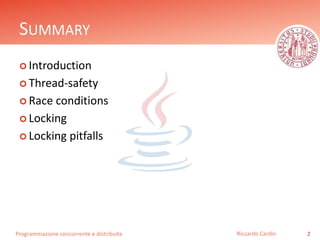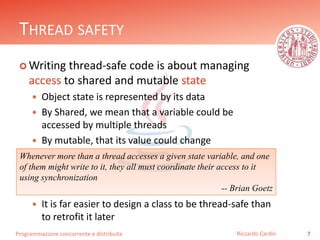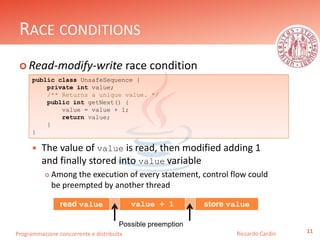Java- Concurrent programming - Synchronization (part 1)
- 1. CONCURRENT PROGRAMMING SYNCHRONIZATION (PART 1) PROGRAMMAZIONE CONCORRENTE E DISTR. Università degli Studi di Padova Dipartimento di Matematica Corso di Laurea in Informatica, A.A. 2015 – 2016 [email protected]
- 2. Programmazione concorrente e distribuita SUMMARY Introduction Thread-safety Race conditions Locking Locking pitfalls 2Riccardo Cardin
- 3. Programmazione concorrente e distribuita INTRODUCTION Threads can reduce development cost and improve the performance application Exploiting multiple processors Improved throughput by utilizing available processors Simplicity of modeling Use every thread to do a specific task is simplier than using one thread to do them all Simplified handling of asynchronous events Prevention of server’s stall while it is fulfilling a request More reponsive user interfaces Use of different threads for GUI and event management Event dispatch thread (EDT) 3Riccardo Cardin
- 4. Programmazione concorrente e distribuita INTRODUCTION Risks of threads Safety hazards Without sufficient synchronization, the ordering of operations in multiple threads is unpredictable 4Riccardo Cardin public class UnsafeSequence { private int value; /** Returns a unique value. */ public int getNext() { return value++; // Three operations: read, add and store } } With unlucky timing, two threads could call getNext and receive the same value
- 5. Programmazione concorrente e distribuita INTRODUCTION Risks of threads Liveness hazards An activity gets into a state such that it is permanently unable to make forward progress Dining philosophers problem Performance hazards Poor service time, responsiveness, throughput, resource consumption, or scalability Context switch is not cost free 5Riccardo Cardin If thread A is waiting for a resource that thread B holds exclusively, and B never releases it, A will wait forever.
- 6. Programmazione concorrente e distribuita INTRODUCTION 6Riccardo Cardin
- 7. Programmazione concorrente e distribuita THREAD SAFETY Writing thread-safe code is about managing access to shared and mutable state Object state is represented by its data By Shared, we mean that a variable could be accessed by multiple threads By mutable, that its value could change It is far easier to design a class to be thread-safe than to retrofit it later 7Riccardo Cardin Whenever more than a thread accesses a given state variable, and one of them might write to it, they all must coordinate their access to it using synchronization -- Brian Goetz
- 8. Programmazione concorrente e distribuita THREAD SAFETY There are three ways to fix a mutable shared variable Don’t share the state variable across threads Make the state variable immutable Use synchronization whenever accessing it Object oriented techniques favor thread safety Encapsulation Immutability Clear specification of invariants 8Riccardo Cardin Stateless objects are always thread-safe. -- Brian Goetz
- 9. Programmazione concorrente e distribuita THREAD SAFETY 9Riccardo Cardin
- 10. Programmazione concorrente e distribuita RACE CONDITIONS Race conditions The correctness of a computation depends on relative timing of multiple threads at runtime Atomicity A set of statements is not atomic if they are not executed in a single, indivisible operation Read-modifiy-write Check-then-act 10Riccardo Cardin A class is thread-safe if it behaves correctly when accessed from multiple threads, regardless of the scheduling or interleaving of the execution of those threads by the runtime environment. -- Brian Goetz
- 11. Programmazione concorrente e distribuita RACE CONDITIONS Read-modify-write race condition The value of value is read, then modified adding 1 and finally stored into value variable Among the execution of every statement, control flow could be preempted by another thread 11Riccardo Cardin public class UnsafeSequence { private int value; /** Returns a unique value. */ public int getNext() { value = value + 1; return value; } } read value value + 1 store value Possible preemption
- 12. Programmazione concorrente e distribuita RACE CONDITIONS Check-then-act race condition Lazy initialization The boolean expression depends on a value that is modified according to it 12Riccardo Cardin public class LazyInitRace { private ExpensiveObject instance = null; public ExpensiveObject getInstance() { // Check-then-act if (instance == null) instance = new ExpensiveObject(); return instance; } } check instance create object store instance Possible preemption
- 13. Programmazione concorrente e distribuita RACE CONDITIONS Compound actions Sequences of operations that must be executed atomically in order to remain thread-safe. Read-modify-write and Check-then-act must always be atomic to be thread-safe Atomicity is relative to operation that are executed on shared state The java.util.concurrent.atomic package contains atomic variable classes for effecting atomic state transitions 13Riccardo Cardin public class SafeSequence { private AtomicInteger value; public int getNext() { return value.incrementAndGet(); // Atomic read-modify-write } }
- 14. Programmazione concorrente e distribuita RACE CONDITIONS 14Riccardo Cardin
- 15. Programmazione concorrente e distribuita SHARING STATE Writing correct concurrent programs is primarily about managing access to shared, mutable state It’s all about memory visibility We want to ensure that when a thread modifies the state of an object, other threads can actually see those changes If shared state is represented by more than one variable, atomic classes are not useful 15Riccardo Cardin public class UnsafeCachedSequence { private AtomicInteger lastValue; private AtomicInteger value; public int getNext() { // Invariant of the class is not satisfied anymore lastValue.set(value.get()); return value.incrementAndGet(); } }
- 16. Programmazione concorrente e distribuita LOCKING To preserve state consistency, update related state variable in a single atomic operation Java has a built-in locking mechanism for enforcing atomicity: synchronized block But, it is easier to understand the synchronized keyword after having seen locks in isolation... 16Riccardo Cardin synchronized (lock) { // Access or modify shared state guarded by lock } Object that will serve as lock Block code to be guarded by the lock
- 17. Programmazione concorrente e distribuita LOCKING Reentrant locking Use a Lock to protect a code block The construct guarantees that only one thread at time can enter the critical section Always release the lock in a finally block to prevents deadlocks The class ReentranctLock implements basic functionalities of a lock 17Riccardo Cardin myLock.lock(); // a ReentrantLock object try { // Operation in this block are executed atomically } finally { // make sure the lock is unlocked even if an // exceptions thrown myLock.unlock(); }
- 18. Programmazione concorrente e distribuita LOCKING Reentrant locking The lock acts as mutual exclusion locks 18Riccardo Cardin public class SafeCachedSequence { private Lock lock = new ReentrantLock(); private int lastValue; private int value; public int getNext() { // Invariant of the class is now satisfied lock.lock(); try { lastValue = value; value = value + 1; int result = value; } finally { lock.unlock(); } return result; } } Now the invariant of the class is guaranteed by the lock: value and lastValue will always be updated in a consistent way
- 19. Programmazione concorrente e distribuita LOCKING Reentrant locking 19Riccardo Cardin Thread 1 Thread 2 getNext getNext Unsynchronized Thread 1 Thread 2 getNext getNext Synchronized
- 20. Programmazione concorrente e distribuita LOCKING Reentrant locking Different threads have to synchronize using the same instance of the lock It is called reetrant because a thread can repeatedly acquire a lock that it already owns The lock has a hold count that keeps track of the nested calls to the lock method Prevents deadlocks wrt the subclass mechanism Every object in Java (since 1.0) has an intrinsic lock The synchronized keyword on a method protects the access to that method using this reference as lock object All method’s code is guarded 20Riccardo Cardin
- 21. Programmazione concorrente e distribuita LOCKING Intrinsic locking To call the method, a thread must acquire the intrinsic object lock Static synchronized methods use the Class object as lock. 21Riccardo Cardin public synchronized void method() { // method body } // ...is equivalent to public void method() { this.intrinsicLock.lock(); try { // method body } finally { this.intrinsicLock.unlock(); } }
- 22. Programmazione concorrente e distribuita LOCKING Intrinsic locking suffers of performance issues Use synchronization by Lock object Or synchronized block It uses the reference to an object that will serve as lock 22Riccardo Cardin public class SafeCachedSequence { private Object lock = new Object(); private int lastValue; private int value; public int getNext() { synchronized (lock) { lastValue = value; value = value + 1; int result = value; } return result; } }
- 23. Programmazione concorrente e distribuita LOCKING 23Riccardo Cardin
- 24. Programmazione concorrente e distribuita LOCKING PITFALLS All the accesses to a mutable shared variable must be performed with the same lock held Not only compound actions Not all data needs to be guarded by a lock Only mutable data All the variables involved in the same invariant must be guarded by the same lock It is not sufficient to use intrinsic lock on every method 24Riccardo Cardin // Not thread-safe if (!vector.contains(element)) vector.add(element);
- 25. Programmazione concorrente e distribuita LOCKING PITFALLS Poor concurrency Limits by the availability of processing resources, not by the structure of application itself CPU intensive and I/O operations must be outside synchronized blocks Acquiring and releasing a lock has some overhead Not break down synchronized blocks too far 25Riccardo Cardin There is frequently a tension between simplicity and performance. When implementing a synchronization policy, resist the temptation to prematurely sacrifice simplicity (potentially compromising safety) for the sake of performance. -- Brian Goetz
- 26. Programmazione concorrente e distribuita EXAMPLES 26Riccardo Cardin https://github.com/rcardin/pcd-snippets
- 27. Programmazione concorrente e distribuita REFERENCES Chap. 1 «Introduction», Java Concurrency in Practice, Brian Goetz, 2006, Addison-Wesley Professional Chap. 2 «Thread Safety», Java Concurrency in Practice, Brian Goetz, 2006, Addison-Wesley Professional Chap. 3 «Sharing Objects», Java Concurrency in Practice, Brian Goetz, 2006, Addison-Wesley Professional Dining philosophers problem https://en.wikipedia.org/wiki/Dining_philosophers_problem Chap. 14 «Multithreading», Core Java Volume I - Fundamentals, Cay Horstmann, Gary Cornell, 2012, Prentice Hall Intrinsic Locks and Synchronization https://docs.oracle.com/javase/tutorial/essential/concurrency/lock sync.html 27Riccardo Cardin



























